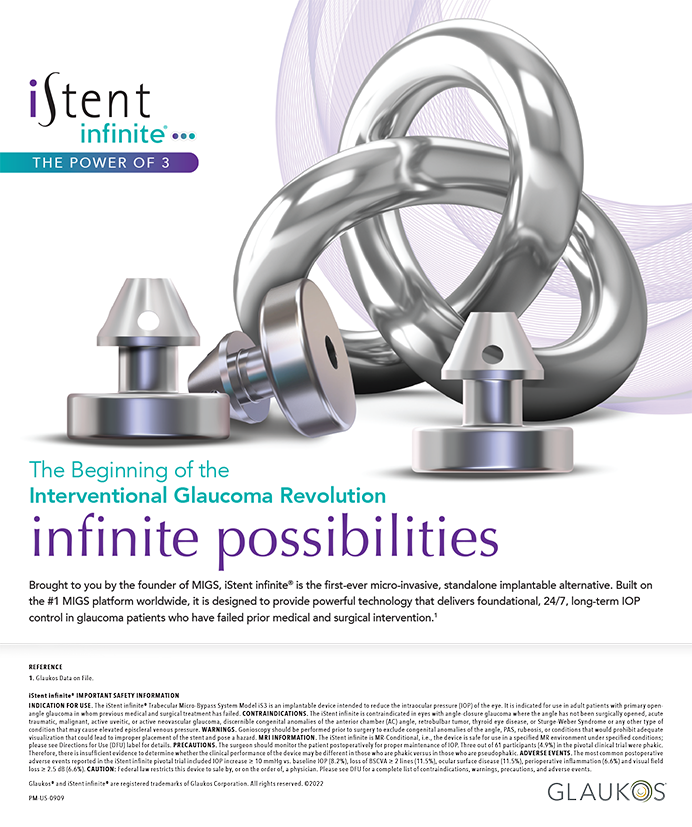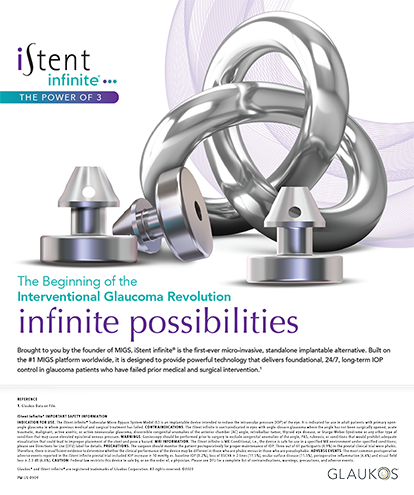Cataract surgeons regularly encounter patients with ocular comorbidities and high-risk features for intraoperative and postoperative complications. In my practice, 60% of binocularly sighted patients have a condition or an anatomic characteristic that makes their surgery nonroutine or reduces their final visual outcome. The prevalence of ocular comorbidity increases to 80% for monocularly sighted patients. Two of the more commonly encountered high-risk anatomic features are the very small eye and the very large eye.
THE SMALL EYE
The prototypical small eye is the nanophthalmic eye with an anteroposterior dimension of less than 17 mm, thick-walled sclera, and a choroid that is prone to effusion under conditions of hypotony. Effusions in short eyes are relatively uncommon in my experience, especially when the eye is pressurized throughout most steps of surgery, but the ophthalmologist must be prepared to handle this complication. It is common to encounter limited space within a very shallow anterior chamber. Anterior segment crowding predisposes the small eye to endothelial trauma, iris chafing, and iris prolapse. Often, the pupil is small, and the iris is floppy. These eyes frequently sit rather deeply in the orbit. Making matters worse, a short axial length reduces the accuracy of lens power calculations, so many of these eyes wind up hyperopic after surgery. What should the cataract surgeon do differently for these patients?
I think it is best to administer a block with a posterior orbital injection or, alternatively, perform the surgery under general anesthesia, especially in the monocular setting. These patients often experience discomfort from iris manipulation when surgery is performed under topical anesthesia. I always have epinephrine or phenylephrine available and inject them if the pupil is small. I coat the corneal endothelium with a dispersive ophthalmic viscosurgical device (OVD), and I inject a highly cohesive viscoelastic beneath the dispersive OVD to maximize the working space and mydriasis. If the anterior chamber remains insufficiently deep to allow the capsulorhexis and safe phacoemulsification, I perform a limited dry pars plana vitrectomy.
It is important to create reasonably long corneal tunnels for the paracentesis and cataract incisions. The iris has a strong tendency to find the incisions in short eyes. When injecting the OVD, I monitor the subincisional iris. If it begins to mound up toward the incision, I immediately stop the injection. Figure 1 shows an eye that experienced iris prolapse during surgery. If the iris prolapses through either or both incisions, it is usually best to halt surgery, leave the iris in the prolapsed state, and open a new phaco incision between a paracentesis and the original phaco tunnel. The iris generally will not prolapse through the new incision. Attempting to reposition the iris at this stage usually results in poor cosmesis, traumatic iridotomies, and pigment dispersion. Once the capsulorhexis is complete and the anterior third or so of the lens has been removed, the working space improves, and surgery generally proceeds uneventfully. I inject a dispersive OVD as needed to protect the endothelium.
If the anterior chamber shallows to the point of collapse during surgery and the eye becomes firm, a choroidal effusion may be present. Aqueous misdirection can also occur but is less likely. A blind pars plana vitrectomy should never be performed if there is any chance of choroidal hemorrhage or effusion. Instead, the surgeon should close the incisions and inspect the posterior segment with an indirect ophthalmoscope. In most cases, there will be a choroidal effusion. If a suprachoroidal hemorrhage is present, it is wise to terminate the procedure. If an effusion is present and the ophthalmologist is prepared, he or she can open the conjunctiva and establish drainage sclerotomies over the pars plana in multiple quadrants. Doing so should reduce the IOP, deepen the anterior chamber, and allow surgery to proceed.
I find the Hoffer Q and Haigis formulas best for IOL power calculation in very short eyes. In my experience, however, they underestimate the power truly needed, especially if the anterior chamber is deeper than expected. I often choose an IOL that is 1.00 or more diopters higher in power than the calculated amount.
THE LARGE EYE
Large eyes are generally easier to manage than very small eyes. Figure 2 shows an extremely large eye. The primary problem of the highly myopic eye is the tendency for the lens-iris diaphragm to move posteriorly when the eye is pressurized with an OVD or a phaco probe. Under topical anesthesia, the sudden increase in pressure and posterior vaulting of the iris and lens can cause the patient considerable discomfort. Scleral wall forces are greater in myopic than in normal eyes at the same IOP. Zonular stretching from a sudden expansion of the anterior chamber volume or reverse pupillary block also causes patients pain. I am careful to pressurize these eyes slowly, and I target a lower IOP during surgery. Newer phaco equipment with active fluidics and programmable pressure ramps can alleviate some of the described difficulties.
IOL power calculation can be problematic in the highly myopic eye. Optical biometry can target the locus of best fixation, which is often not the fovea. I recommend using the SRK/T formula. Eyes that calculate out to negative dioptric powers tend to wind up hyperopic if emmetropia is targeted. I always add +1.50 D to the power of a negative lens to achieve emmetropia. Single-piece foldable lenses generally are not available in the negative and low plus powers. For that reason, highly myopic patients who receive three-piece IOLs are more likely than those with single-piece IOLs to develop posterior capsular striae and experience starbursts through points of light at night. This problem can be remedied by laser capsulotomy.
CONCLUSION
Large and small eyes can present challenges, but with attention to specific details, surgeons can manage these cases in a way that produces successful outcomes. These patients probably deserve a little extra counseling because of their high-risk anatomy, but in skilled hands, they can reasonably expect their surgery to proceed uneventfully and their final outcome to be good.
Kevin M. Miller, MD, is the Kolokotrones professor of clinical ophthalmology, David Geffen School of Medicine at UCLA, Jules Stein Eye Institute. Dr. Miller may be reached at (310) 206-9951; kmiller@ucla.edu.


